Gardeners in Maryland enjoy rich nutrient-rich soil that provides the perfect conditions for many different plants and flowers. Throughout the late spring and summer, the state blossoms with many different wildflowers. Maryland spans four USDA Hardiness Zones — zones 5, 6, 7, and 8, offering a varied selection of perennials that can thrive here.
In this guide, we will identify the best perennial flowers that are well-suited for planting in different parts of Maryland, helping you in crafting a garden that blossoms beautifully. Join us as we dig into the colorful world of Maryland’s perennial flowers.
1. Common Blue Violet (Viola sororia)
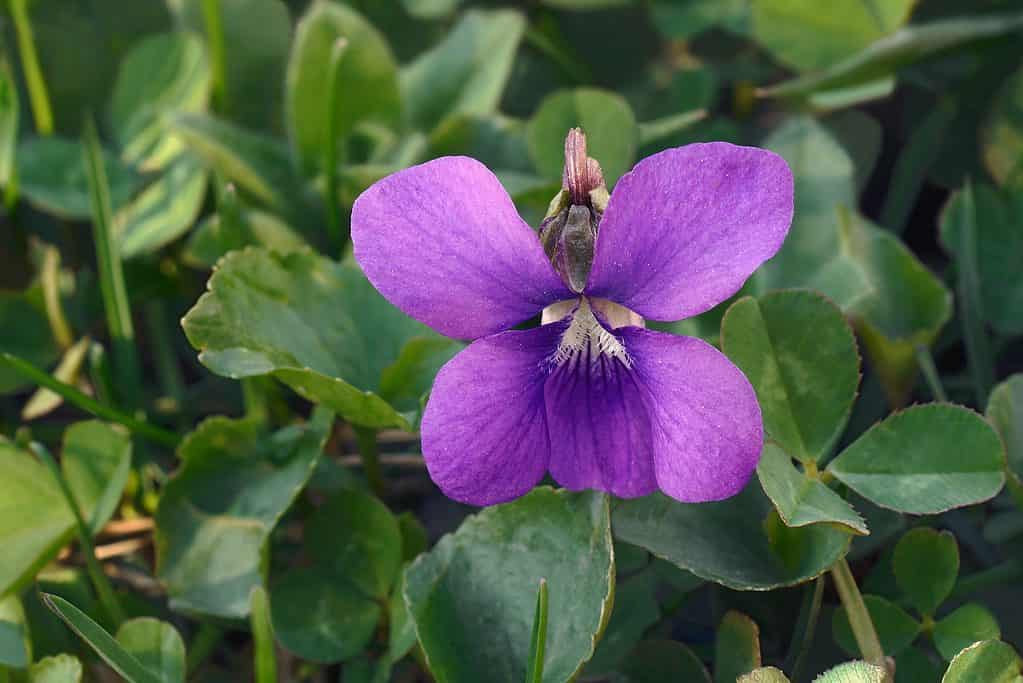
This flower is very common in Maryland and is the official state flower of several states.
©Nikolay Kurzenko/Shutterstock.com
The common blue violet is one of the most beautiful native perennial flowers in Maryland. It is a compact plant that doesn’t grow stems. Its bright, heart-shaped leaves provide a beautiful backdrop to the large, striking blue-violet blossoms that showcase prominent white centers. Each bloom perches gracefully on its separate, leafless stem.
This delightful plant graces gardens primarily in the middle of spring and occasionally until the late summer. The beauty of this perennial has not gone unnoticed, as it has been named the official state flower of New Jersey, Rhode Island, Illinois, and Wisconsin.
Effortlessly reaches a height and spread of 6-10 inches.
Growing Tips
- Prefers partial to light shade; can endure full sun with sufficient watering.
- Thrives in soil that drains well and maintains a moderate level of moisture.
- Naturally, it multiplies in favorable conditions through self-seeding.
2. Atamasco Lily (Zephyranthes atamasca
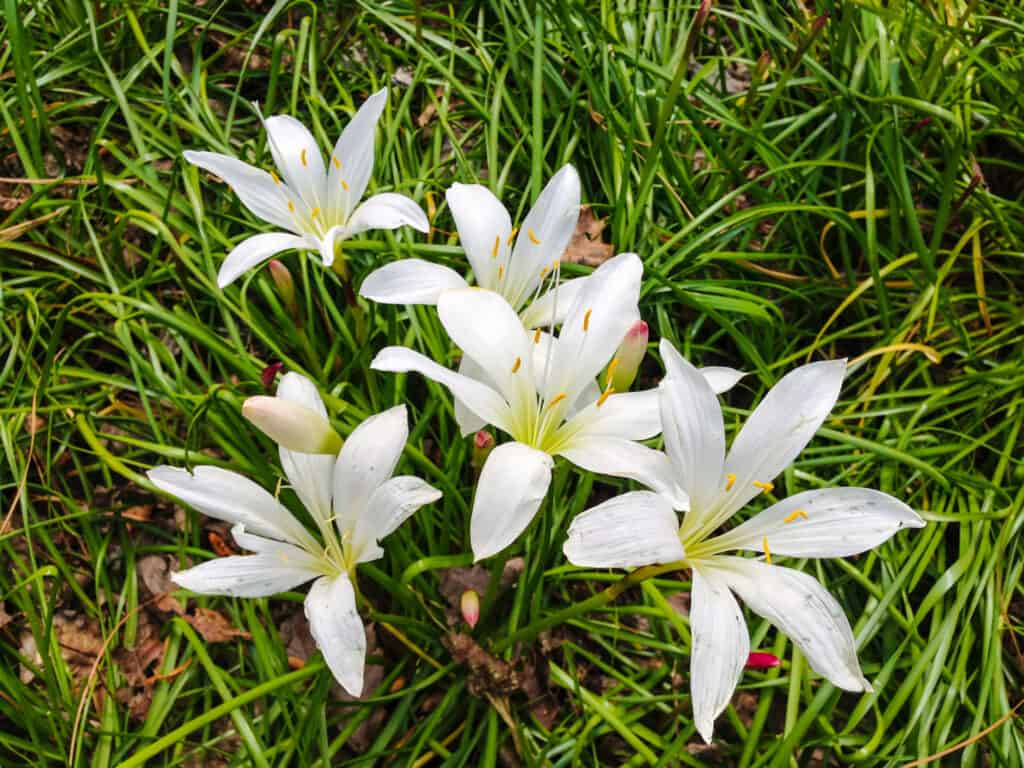
This perennial generally blooms after periods of rain, giving it the nickname “rain lily”.
©iStock.com/LCBallard
The atamasco lily is a perennial plant that sprouts from bulbs, featuring expansive, white, lily-like flowers that sometimes appear in a soft pink color. These blooms have a distinctive look with six separate lobes that merge at the base, forming a funnel shape, which is highlighted by vivid yellow stamens in the center. You can spot these magnificent blooms emerging individually on leafless stems that rise from clumps of bright green, slender, grassy leaves, typically from early spring through the onset of summer. The atamasco lily is a perennial that thrives in only the warmest parts of Maryland, particularly the southern coastal regions.
Also known as the rain lily, it has a tendency to burst into bloom following a rainy spell, adding a spectacular sight to gardens. After its blooming phase, the Atamasco lily recedes quickly into dormancy, so it’s advised to pair it with companion plants that can take over the spotlight.
The plant can attain a height ranging between 6 and 18 inches and spreads out 12 to 24 inches.
Growing Tips
- Does well in sunny to partially shaded areas.
- Prefers humus-rich soil with a neutral to slightly acidic pH, which retains moisture yet offers good drainage.
- Can withstand areas prone to seasonal flooding.
3. Giant Ironweed (Vernonia gigantea)
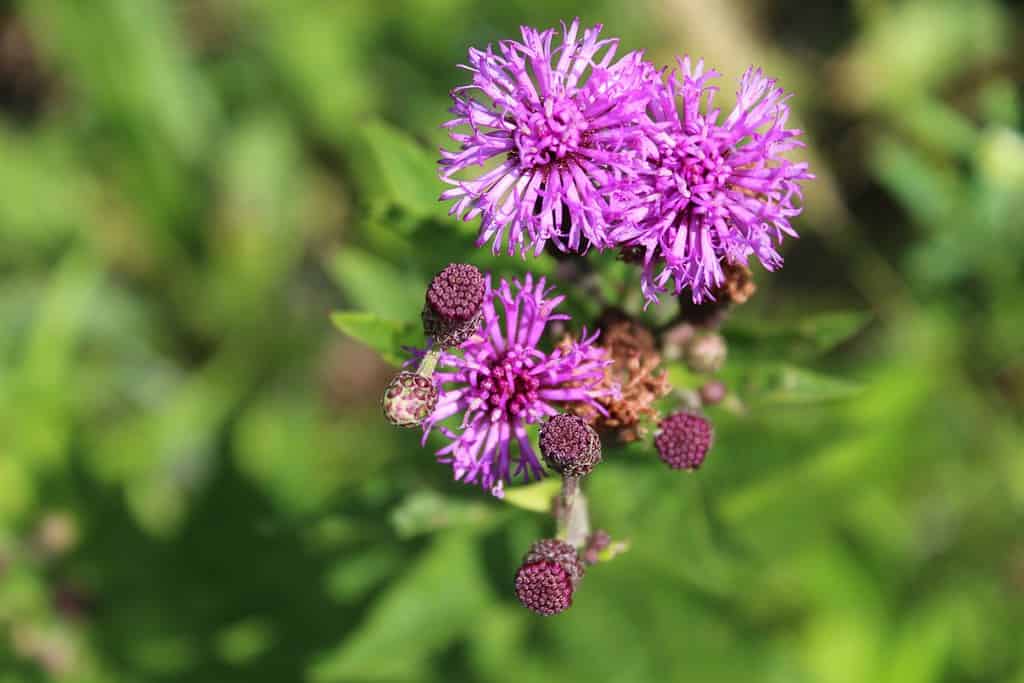
Ironweed is an extremely unique and beautiful perennial flower in Maryland.
©John Ruberry/Shutterstock.com
The giant ironweed is a towering perennial flower in Maryland, forming clumps and displaying large, flat clusters of small, purple flowers with delicate petals, typically in the late summer to early fall. These flower clusters are a spectacle, with each having anywhere from 30 to 50 tiny flowers. These flamboyant flower heads, situated on rigid, erect stems adorned with lance-shaped, dark green leaves, are a magnet for birds and butterflies.
Giant ironweed fits perfectly at the rear of flower beds or in narrow spaces. You can also place this plant near water as it flourishes in areas bordering ponds and streams.
This species can grow to a height of 5 to 8 feet and expands to a width of 3 to 6 feet.
Growing Tips
- Prefers locations with full sun to partial shade and adapts well to medium to wet soil conditions.
- Generally not affected by serious pests or diseases and is resistant to deer.
4. Virginia Marsh St. Johnswort (Triadenum virginicum)
The Virginia Marsh St. Johnswort is a captivating perennial wildflower that graces gardens with its small, fragile blossoms from the middle to the end of summer. Each flower, measuring about 3/4 inches, showcases a delightful array of five petals that transition in color from white to pink to red, accompanied by nine stamens with yellow tips. Additionally, they grow in clusters, inviting butterflies and other pollinators. As the season progresses, they give way to tiny, dry fruits that burst open upon maturing.
This perennial in Maryland is an excellent choice for damp, partially shaded locales like bogs or the borders of streams and ponds.
It achieves a moderate height of 12 to 18 inches and a spread of 6 to 10 inches.
Growing Tips
- This perennial flower performs best in locations with light shade, thriving in acidic soils that are either loamy or sandy.
- It’s crucial to balance its exposure to sunlight as prolonged periods can cause the leaves to burn, whereas excessive shade can reduce flower production.
5. Painted Trillium (Trillium undulatum)
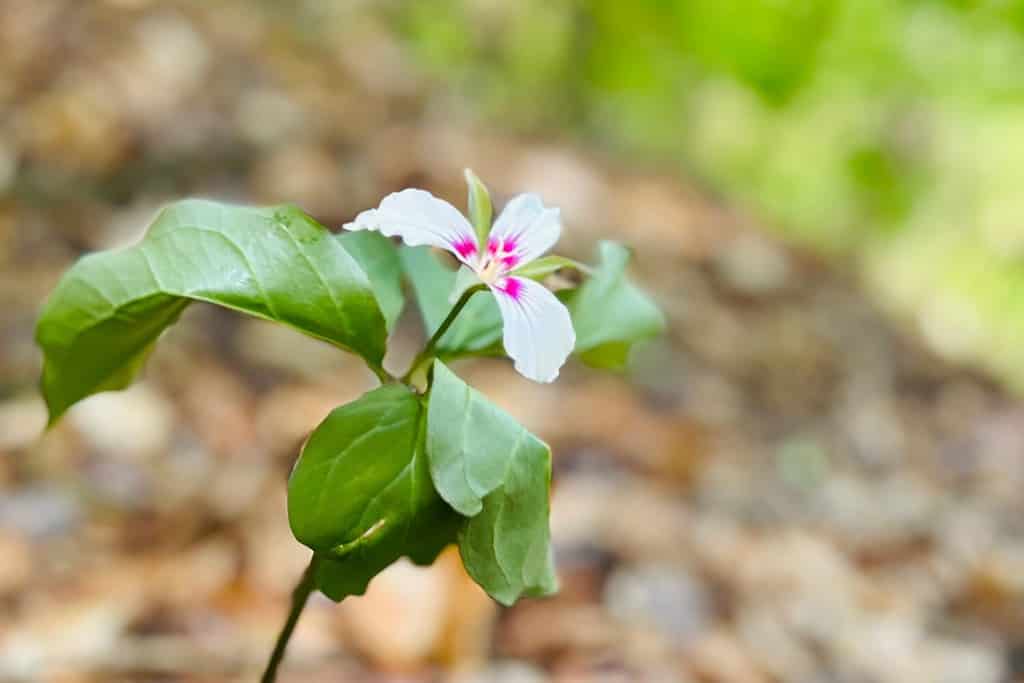
Painted trillium is a beautiful wildflower with white and pink blooms.
©wanderpix/Shutterstock.com
Recognized as one of the most beautiful varieties among woodland trilliums, the painted trillium is a clump-developing perennial. This plant is known for its broad, blue-green leaves forming at the base. From early spring until early summer, it showcases stunning white blossoms with a diameter of 2 inches. The flower is highlighted with a touch of pink, situated above the leaves on a slightly curved stem.
This trillium, which is easy to grow, serves as a picturesque addition to wildflower or woodland gardens, where it can beautifully cover the ground.
Moreover, the plant can reach heights between 8 and 18 inches and spread to 12 inches in width.
Growing Tips
- Thrives best in partially shaded to fully shaded areas, preferring deep soils rich in humus with a moisture level that is well-draining.
- If undisturbed, the plant has the potential to spread gradually, covering more ground over time.
- Given that trilliums enter a dormant phase by midsummer, it is recommended to accompany them with other perennials.
6. Aromatic Aster (Symphyotrichum oblongifolium)
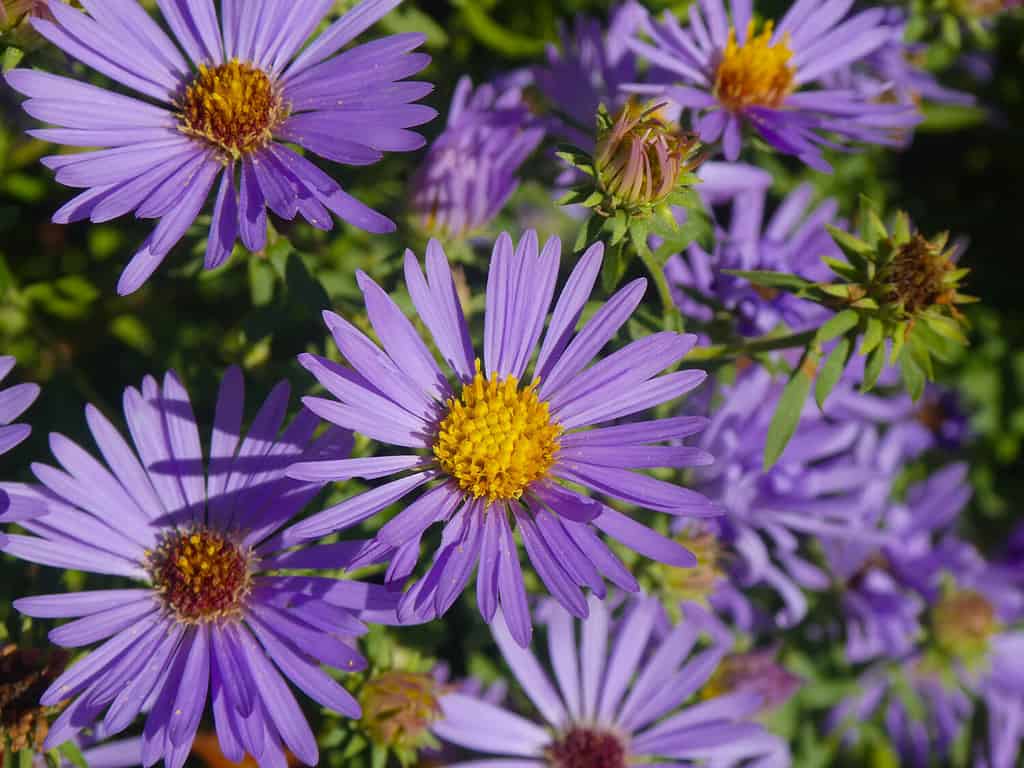
Aromatic aster is an absolutely gorgeous flower with fragrant blooms.
©ForestSeasons/Shutterstock.com
Compact in its growth pattern, the aromatic aster is a bushy perennial that is perfect for Maryland gardens. This plant forms a neat cluster of bright colors, presenting a spectacle of blue-purple daisy-like flowers from late summer to fall. Aromatic aster blooms span about an inch across and boast golden-yellow centers, creating a colorful display.
Crushing the leaves releases a pleasing fragrance into the air. Apart from adding a splash of color during the fall, this perennial is a hassle-free choice for gardens. A well-cared-for aromatic aster can live for more than 5 years! Rich in nectar, they are also a favorite feeding spot for butterflies and other pollinators.
This plant reaches a height of 12 to 24 inches and can spread between 12 and 36 inches in width.
Growing Tips
- Best grown in full sunlight, adapting well to soils that are well-draining with dry to medium moisture levels.
- Has a good tolerance towards drought, salt, and infertile soils.
- The aromatic aster has a tendency to self-seed in areas where it thrives and can spread gradually through stolons, although managing its spread is relatively easy.
7. Celandine Poppy (Stylophorum diphyllum)

This golden-yellow flower is a gorgeous addition to any Maryland garden.
©Timothy H Brown Jr/Shutterstock.com
The celandine poppy is a prominent clump-forming perennial that produces clusters of radiant yellow flowers. These blooms look very similar to poppies and measure up to 2 inches in diameter. This perennial flower generally emerges in early spring. Celandine poppies stand on leafy stems, towering over the base foliage characterized by light green leaves with finger-like lobes.
Given the chance, this perennial can spread over expansive spaces, creating a golden blanket on the ground. Be aware that it might retreat into dormancy, with its leaves vanishing by the end of summer if not situated in constantly damp soil. This plant is a stunning addition to gardens with moist, shadowy spots.
This variety can grow between 12 and 18 inches in height, extending to a width of 10 to 12 inches.
Growing Tips
- Flourishes in partially to fully shaded areas and is best suited to soil conditions ranging from average to damp.
- Generally remains unaffected by major pests or diseases.
8. Brown-Eyed Susan (Rudbeckia triloba)

One of the hardiest plants on this list is the brown-eyed Susan, which can grow in most parts of the USA.
©APugach/Shutterstock.com
The well-known brown-eyed Susan is generally grown as a biennial or a short-lasting perennial flower in Maryland. This flower has golden-yellow blooms, each spanning 1-2 inches across. From the middle of summer through to the frost, these flowers can be seen irrespective of the prevailing weather conditions. Every bloom features 6-12 petal-like rays encircling a deep brown central cone, giving your summer garden an extended color.
Acknowledged with the esteemed Award of Garden Merit from the Royal Horticultural Society, it forms a basal cluster of tri-lobed leaves. Brown-eyed Susans are extremely hardy plants, with the flowers remaining throughout the colder months.
This plant reaches heights of 2 to 3 feet and spreads out 12 to 18 inches in width.
Growing Tips
- Ideal in spots with abundant sunlight, favoring soil conditions that are well-draining and maintain a moderate moisture level.
- Can endure slight shade, yet may require additional support if positioned in overly shaded areas. Demonstrates resilience to high temperatures and periods of drought.
9. Rose Pogonia (Pogonia ophioglossoides)

A native orchid to the eastern US, rose pogonia is a vibrant perennial bloom.
©Brian Woolman/Shutterstock.com
The rose pogonia graces Maryland gardens with its slender and upright stem and a solitary pink or white flower. The bloom is generally around one inch wide and emerges from late spring to late summer. The exquisite flower has three elliptical sepals, a pair of oblong petals, and a prominent lip that captivates with its deep pink fringe and crimson-purple veining.
This plant can reach a height between 12 and 24 inches and expands to cover a width of 24 to 36 inches.
Growing Tips
- Flourishes under the generous warmth of full sun and prefers soil that retains a regular moisture level and has a slight acidity.
- If the available water source has a higher pH level, it’s recommended to hydrate the plant with rainwater or distilled water to maintain soil acidity.
10. Creeping Phlox (Phlox stolonifera)

This intriguing flower species can create a blanket of pinkish-purple blooms.
©speakingtomato/Shutterstock.com
Creeping phlox is a well-loved evergreen ground cover widely recognized for its blanket of pink, purple, or white star-shaped blossoms. These beautiful blooms cover its dark green leaves from early spring to early summer. This hardy plant, which originates from the eastern and central regions of the US, naturally finds its home in locations with somewhat arid, rocky, or sandy conditions, including open forests and hillsides.
This fast-growing plant swiftly covers even the most barren soils, creating a colorful floral carpet that lasts for nearly a month. Besides brightening up rocky areas, borders, and slopes, it effectively prevents soil erosion. An added bonus is its ability to attract butterflies and other pollinators while being relatively resistant to diseases and pests.
The plant maintains a petite height of 3-6 inches but can quickly spread to cover an area of 12-24 inches in width.
Growing Tips
- Best grown under the full sun, although it can manage well in areas with dappled shade.
- It flourishes in soils rich in organic matter with a moderate level of moisture and excellent drainage.
- Ensuring proper drainage is key to promoting healthy growth.
11. American Lotus (Nelumbo lutea)
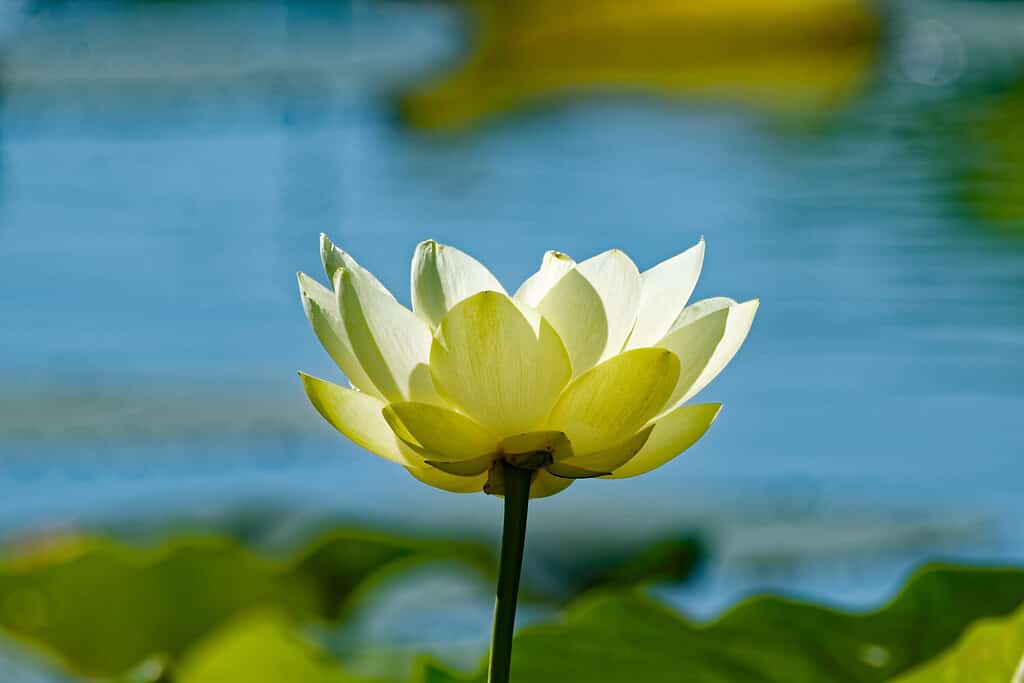
American lotus thrives in lakes, ponds, and other stagnant, nutrient-rich freshwater bodies.
©Aria_RJWarren/Shutterstock.com
Not all lotus flowers originate in Japan! The American lotus is a prominent aquatic perennial known for its expansive, umbrella-shaped leaves. Each leaf is about 2 feet wide and often extends above the water surface. Its large, bright yellow flowers, radiating a pleasant fragrance, can measure up to 12 inches in diameter and perch on tall, rigid stems that surpass the foliage. These blossoms grace the summer season, revealing their glory in the morning hours and retiring by the late afternoon, typically over a span of three days. The American lotus thrives in all regions of Maryland as its hardiness zone ranges from 4 to 11.
This plant tends to spread quite vigorously through its elongated rhizomes that anchor in the mud. Given its expansive nature, we highly recommend confining it within containers or small pond spaces. This prevents it from overtaking larger water bodies.
It can reach a height ranging from 3 to 6 feet and spread across an area of 3 to 4 feet.
Growing Tips
- Ideal growth is observed in sunny locations with soil that is both organically rich and retains moisture well.
- When introducing it to water gardens or smaller ponds, utilize planting baskets and submerge them up to 24 inches underwater, ensuring the plant crowns are covered.
12. Scarlet Bee Balm (Monarda didyma)
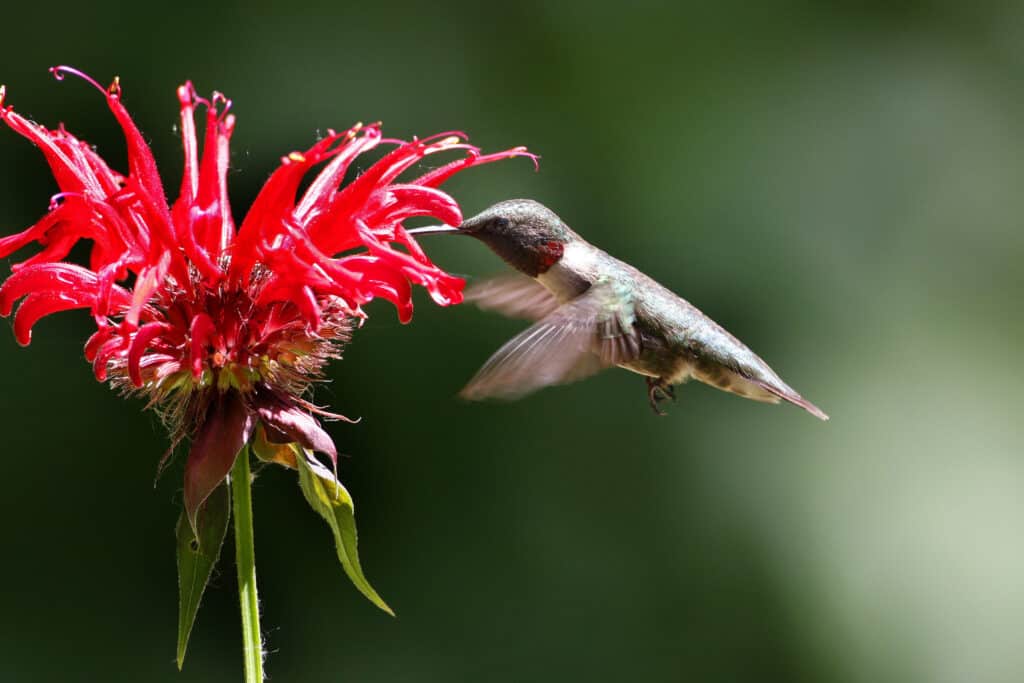
Scarlet bee balm is a perennial flower in Maryland that attracts pollinators.
©Chris Alcock/Shutterstock.com
Admired for its vibrant blooms and refreshing scent, the scarlet bee balm is a perennial plant that forms clumps and displays striking red, two-lipped flowers. These blossoms, spanning 3-4 inches across, form in dense, spherical clusters at the stem tips, offering a feast for the eyes from late spring to mid-fall. The fiery flowers, supported by a collar of red-brushed bracts, have a remarkable knack for drawing in a bustling crowd of bees, butterflies, and hummingbirds.
This striking plant adds a burst of enduring color to various settings — be it a perennial border, a rustic cottage garden, prairies, meadows, herb gardens, or the areas bordering ponds and streams, marking its presence vividly.
Growing Tips
- Thrives optimally in sunny locations with soil that is moderately nourished, rich in organic matter, and maintains a good balance of moisture yet drains well.
- In regions experiencing hot summers, the plant benefits from some shade during the afternoon hours.
- Take measures to shield it from excessive moisture during the winter and ensure it remains adequately hydrated during the summer season.
Summary of the Best Perennial Flowers for Maryland
| Flower | Blooming Period |
|---|---|
| Common Blue Violet | Mid-spring to late summer |
| Atamasco Lily | Early spring to early summer |
| Giant Ironweed | Late summer to early fall |
| Virginia Marsh St. Johnswort | Mid to late summer |
| Painted Trillium | Early spring to early summer |
| Aromatic Aster | Late summer to fall |
| Celandine Poppy | Early spring to early summer |
| Brown-Eyed Susan | Mid-summer to fall |
| Rose Pogonia | Late spring to late summer |
| Creeping Phlox | Mid to late spring |
| American Lotus | Mid to late summer |
| Scarlet Bee Balm | Late spring to fall |
The photo featured at the top of this post is © Brian Woolman/Shutterstock.com
Thank you for reading! Have some feedback for us? Contact the AZ Animals editorial team.







